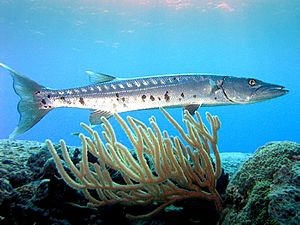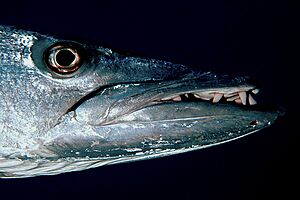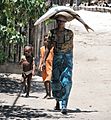Barracuda facts for kids
Quick facts for kids BarracudaTemporal range: Early Eocene to Present
|
|
|---|---|
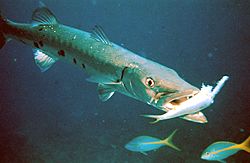 |
|
| Great barracuda, Sphyraena barracuda, with prey | |
| Scientific classification | |
| Kingdom: | |
| Phylum: | |
| Class: | |
| Order: | |
| Family: |
Sphyraenidae
|
| Genus: |
Sphyraena
Klein, 1778
|
Barracudas are long, speedy fish that can grow up to 6 feet (about 1.8 meters) long. You can find them in warm, tropical and subtropical oceans all around the world. They belong to the genus Sphyraena, which is the only group in the Sphyraenidae family.
These fish are known for their sharp teeth and quick movements. Divers sometimes remove shiny objects because barracudas might mistake them for the silver fish they like to eat. Barracudas usually live near the surface of the water, often around sea grass and coral reefs.
Contents
What Do Barracudas Look Like?
Barracudas have a long, snake-like body. They have very sharp, fang-like teeth, similar to piranhas, but all different sizes. These teeth are set in their large jaws. Their heads are pointed, and many species have an underbite, meaning their lower jaw sticks out.
Their gill covers are smooth and covered with tiny scales. Barracudas have two dorsal fins that are far apart. The front fin has five stiff spines, and the back fin has one spine and nine soft rays. The back dorsal fin is about the same size as their anal fin and sits right above it.
A clear lateral line runs straight from their head to their tail. Their front dorsal fin can usually be pulled back into a groove. The tail fin (caudal fin) is shaped like a fork and sits at the end of a strong tail base. Their pectoral fins are low on their sides. They also have a large swim bladder to help them float.
Most barracudas are dark gray, dark green, white, or blue on top. Their sides are silvery, and their belly is a chalky white. The exact colors can change a bit between different types of barracudas. Some species have irregular black spots or dark stripes along their sides. Their fins might be yellowish or dark. While most barracudas live in the ocean, some, like the great barracuda, can also live in brackish water (a mix of fresh and salt water).
Some barracuda species can grow very large. For example, Sphyraena sphyraena can reach up to 165 cm (about 5.4 feet) long. You can find this type in the Mediterranean Sea and the eastern Atlantic Ocean. Another large species, Sphyraena picudilla, lives along the Atlantic coast of tropical America, from North Carolina to Brazil, and also near Bermuda. Other barracuda species live in oceans all over the world, such as Sphyraena argentea off the coast of California, and Sphyraena jello in the seas around India and Malaysia.
Barracuda Species
The barracuda genus Sphyraena includes many different types of barracudas. Here are a few examples:
- Sphyraena barracuda (Great barracuda)
- Sphyraena argentea (Pacific barracuda)
- Sphyraena forsteri (Bigeye barracuda)
- Sphyraena jello (Pickhandle barracuda)
- Sphyraena sphyraena (European barracuda)
How Barracudas Behave and What They Eat
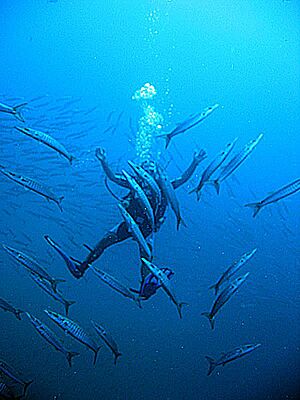
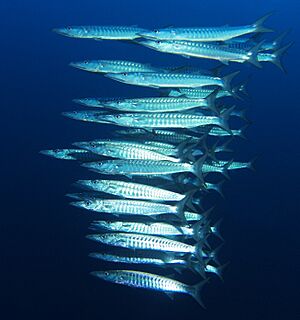
Barracudas are fierce predators. They hunt by surprise, using short bursts of speed up to 27 mph (43 km/h) to catch their prey.
Most adult barracudas prefer to hunt alone. However, young and half-grown barracudas often swim together in groups. Barracudas mainly eat other fish, sometimes even fish as big as themselves! They bite off chunks of flesh from larger prey. Barracudas often compete with other fish like mackerel and needlefish, and sometimes even dolphins, for food.
Barracudas eat many kinds of fish. This includes jacks, grunts, groupers, snappers, small tunas, mullets, killifishes, herrings, and anchovies. They simply bite these fish in half. They also seem to eat any smaller food that comes their way.
Barracudas and Humans
Like sharks, some barracuda species have a reputation for being dangerous to swimmers. Barracudas are scavengers, meaning they sometimes follow large predators hoping to eat their leftovers. They might mistake a snorkeler for a large predator. While there have been reports of barracuda bites, these incidents are very rare. They often happen in murky water where visibility is poor.
Barracudas might also mistake shiny objects for prey. There was one rare report of a barracuda jumping out of the water and injuring a kayaker. However, experts say this wound could have been caused by another type of fish called a houndfish.
It's best to avoid hand-feeding or touching large barracudas. Spearfishing near barracudas can also be risky. They are quite capable of biting a piece off a wounded fish on a spear, or even from the arm holding the spear. Humans are not their usual food, but in a hurry, a barracuda might get confused.
Barracudas as Food
Barracudas are popular for both eating and sport fishing. People often eat them as fillets or steaks. However, larger species, like the great barracuda, can sometimes cause a type of food poisoning called ciguatera. If someone gets this food poisoning, they might have an upset stomach, weak limbs, and trouble telling the difference between hot and cold.
In West Africa, people often smoke barracudas. They use the smoked fish in soups and sauces. Smoking helps the soft fish meat stay together in the broth and gives it a smoky flavor.
Images for kids
-
A group of Sphyraena flavicauda off Dayang, Malaysia
-
A woman carrying a barracuda in Madagascar
-
A group of Sphyraena putnamae, in Bora Bora
See also
 In Spanish: Barracuda para niños
In Spanish: Barracuda para niños


